Exploring the Mythic Zodiac
“Cycle of Animations”
Celestics invites you to contemplate the mythic images of the real-sky zodiac. It asserts that what you see in the sky when you visualize the star-patterns according to the “animals” associated with them, mirrors the engrams in your neurolinguistic circuits. The constellation of the Scorpion in the sky mirrors a psychic constellation. As without, so within. Psyche and night sky comprise a single field-dynamic, the stellar-neural continuum. The celestial script interacts with human consciousness in the manner of a biofeedback device. Nothing in the sky causes human behavior; rather, it encodes our behavior and preserves a record of human experience over time.
At first sight, these star-patterns look like a diamond-pointed liquid crystal display, an LED panorama of sights that have been observed by the human species over millennia of time. You perceive the star-patterns, and in the same act of observation, you conceive the mythological figures associated with them. You observe and imagine in a single look. But what is it exactly that you visualize?

I realize that people living in urban areas have limited opportunities to observe the night sky. How important is direct, naked-eye observation of the constellations in learning Celestics? It is a wonderful accessory, but missing out on it does not impede the practice. It enhances the practice enormously, but you can manage without it.
Accessing the “Unconscious”
The full term in Greek for the celestial panorama of constellations on the rim of the ecliptic is zodiakos kyklos.: Ζωδιακός κύκλος. Routinely translated as “circle or belt of animals.” But if you scan the graphics of the constellations, you see immediately that it does not consist of animals. In fact, there are only three animals: a ram, a bull, and a lion. The other figures are human, a pair of twins, a female figure presumed to be a virgin, a yogi-type man wrestling a snake, and a wizard-type male figure. There is a human-horse hybrid, the centaur, and a chimera that combines a goat and a fish. Additionally, there is a crustacean, the crab, an arachnid, the scorpion, and a pair of fishes joined at the tails by a cord. Finally there is a pair of scales, the sole human construct in the group.
Clearly, this is no circle of animals. Kyklos means “cycle,” and zodiakos is a derivative of the root Greek zoe, “alive, animated.” The accurate translation is “cycle of animations.” The celestial panorama is animated, a living picture show. What the pictures show mirrors the activity of human imagination. These images are charged with emotion. They represent the set of psychic constellations that drive our behavior. They are capable of triggering mental-emotional sequences, called fugues, with the power to compel and direct human activity and determine goals. It is normal for the human animal to be immersed in a fugue state all the time. Director David Lynch stated that his films depict in some sequences the dynamics of “the psychogenic fugue.”
But due to the need to function in the external world, and partake in the social order, the action of the fugue has to be pushed down and partially concealed. It does not however sink into “the unconscious.” It persists and hovers at the borderline of normal attention. The fugue runs at the subliminal level, in the subconscious, not in the unconscious. You can easily access it and you often do when you free-associate, give over to fantasy, or indulge in dream-like reverie.
Feeling-Toned Constellations
Around 1905, C. G. Jung began the investigations that formed the groundwork of his later theories. Conducting word association tests at the Burgholzli Clinic near Zurich, he discovered response patterns that he initially called “feeling-toned constellations.” Right there at the dawn of modern psychology, you see the word constellation. Jung applied it to activity of the human psyche in which conscious thought and verbalization merge and mix with emotions, visual imagery, reverie, memory, and primal impulses. To him, a feeling-toned constellation — also called a complex — was an ensemble of interconnected ideas, images, and emotions that cluster around a central emotional theme. Going back to Freudian theory on which Jung relied until his break with Freud around 1912, Jung assumed that these complexes operate outside the range of conscious self-awareness. Operating from an unconscious or repressed (Freud) zone, they significantly influence our thoughts, feelings, and motives. In short, they determine how we compose the narrative of our lives which in turn determines how we live out our lives.
Little did Jung know that what he discovered about feeling-toned complexes could be applied to the immense star-patterns in the sky. Later in his career, Jung relied on astrology for analysis of his patients. Jung tasked his wife, Emma, to cast the horoscopes of his patients, but she used the conventional starless format of the signs, not the real-sky constellations.
One of Jung’s main works is The Archetypes of the Collective Unconscious (1957, Volume 9 in the Bollingen Collection). It is tempting to jump to the conclusion that the mythic images of the Zodiac in Celestics equate directly to that meme. But they do not. In ORIGINS I set out my critique of the concept of the Unconscious. As noted already, the mythic images running the “psychogenic fugue” in your mind right now are not hidden, repressed, or unconscious. They are merely unnoticed. Bear that nuance in mind: unnoticed, but not unconscious, i.e., not inaccessible.
So what does it take to notice them? If you follow the doctrine of modern psychology, you will see that both Freud in his way and Jung in another way insisted that it took long and arduous work to access and process the material in the Unconscious. It that claim true to experience? Is it really so difficult? To quote an amusing meme from the YT channel Pitch Meetings, “Not difficult at all. Actually, its super-easy. Barely an inconvenience.”
You can easily access the so-called “the archetypes of the Collective Unconscious” by turning your attention to what’s unfolding slightly below the threshold of your daily, ordinary awareness. It suffices to shift your power of observation in that direction, and the unnoticed activity comes into view. Even better, you can immediately access these psychic operations by taking a moment to listen to the story you are telling yourself about what you are doing, have done, or intend to do. In other words, tune into how you are running your life-narrative.
Denial is Not a River in Egypt
The second point in my objection to adopting the idiom of Jungian psychology to Celestics goes to the common term, archetype. The Archer, the Bull, the Scales, and so on– are they not archetypes? Yes, you can call them that, but before that word became a popular trope, Jung and others used the German word urbild, “primordial image,” instead of archetype. The problem with archetype is, I find, its rather sterile bearing. Compare an archetype to the X-ray of a living animal. At best, an archetype is a pale mental construct of the living animations in psyche and sky. It is spectral and abstract, compared to the terms primordial image, mythic image, and engram preferred in Celestics. This distinction may look like a semantic quibble, but I have found over time that archetype can be discarded from the vocabulary of Celestics, and nothing is lost.
This issue is pertinent to the inventory of constellations in the zodiac, also called the mythography. The exercise of “working the inventory” introduced here takes you into contemplation of the complete range of celestial images associated with mythic images and narratives, actors both human and divine, perennial themes, and universal story-lines — the material of sidereal mythology.
That being so, it is natural to wonder if the constellations correlate to Jungian archetypes. The answer is, no, they don’t unless you try to force the correlations. It is a fact, widely ignored by most followers of Jungian psychology, that Jung himself initially defined only four archetypes: anima, animus, the shadow, and the self. Later, he loosely expanded these to the Wise Old Man, the Trickster (a variant of the shadow), the Great Mother, Philoman (the Wise old Man), Salome (the Witch), and others. Some Jungians added even more archetypes. Eventually, astrologers who incorporated Jungian theory into the twelve-sign format claimed that there is one archetype for each sign. That is a misleading claim which I do not support anywhere in the inventory of mythic images for Celestics.
The Heuristic Approach
To complete this summary of my deep and longstanding objections to Jungian psychology, let me address this objection: While it may be true that we can skim the operations of the Unconscious in the way I describe, there are many factors in the psyche that resist exposure. They remain buried, denied, repressed, hence, extremely difficult to uncover. The presumed genius of both Freud and Jung is that they warned about these inaccessible factors. Indeed, they did, but I contend that the repressed and buried contents in the Unconscious are not so inaccessible, or hidden behind traumatic memories, as they claimed. I propose that repressed simply means unadmitted. Denial is not an overpowering unconscious mechanism that conceals the truth of what you think and feel. Denial is simply an act of refusing to admit what you innately know. It is way of lying to yourself and to some degree that lie is conscious and intentional. “Repression of unconscious contents,” as the meme goes, is a deliberate act of self-deception, not a mechanism beyond your control.
If that is so, the exploration of how you compose your life-narrative — the primary goal of forensic astronomy — is a direct and provable practice of self-liberation. Investigation of the biographic evidence encoded in the manifold will show you if and how you are lying to yourself. It will uncover what you appear to be repressing and reveal it as unadmitted, rather than unconscious. It can release you from the dissimulating habit of denial, and expose what I have elsewhere called “bad faith,” which is nothing more than a self-deluding act of prevarication. Prevaricate: to evade the truth or speak and act in an evasive, self-concealing manner. Such is the unique benefit of Celestics.
This method you learn in these introductory essays is forensic, i.e, a tool for investigation. What you investigate is not the dynamics of personality, although you can learn a lot about that along the way. What you investigate is the construction and direction of your life-narrative, your biography. Another name for this method is heuristic: involving or enabling discovery or problem-solving through methods such as experimentation, evaluation, and trial and error.” For example, “a hands-on or interactive heuristic approach to learning.”
Naked-Eye Mythology
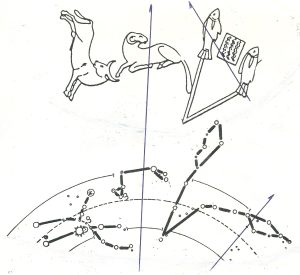
Section of the Dendera Zodiac: Fishes – Ram – Bull. Compare the observable star-to-star signatures with the graphic renderings. The Egyptians who designed the Dendera Zodiac for their Greek students converted the signatures into graphic figures with high accuracy, but they also used special effects, innovations of visualization. Notice how they spin the Bull.
In the investigation of the Zodiac, it’s normal to ask, How come the star-to-star signatures have come to be pictured in various ways in the past, imagined by different cultures over time? Research in sidereal mythology shows that a signature that catches the eye can be rendered graphically in different ways. Lion as Plumed Serpent, Crab as Scarab, or Chambered Nautilus, or Spiderwoman in her web, the Manitu as White Buffalo Calf Woman with her basket or magic plants, and so on. For reasons too complicated to explain, Celestics favors the graphics from the Greco-Latin legacy of skywatching, best preserved in the sacred artifact of the Dendera Zodiac.
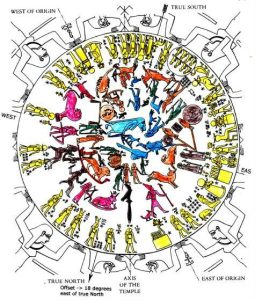
Color-coded rendering of the Dendera Zodiac
Visualizations conformable to the Greco-Roman Zodiac. the 13 Ecliptic constellations are highlighted in dark ochre.
One thing is clear and certain: These visualizations are not arbitrary. Seeing wooly lambs in the sky is not where it all began. In fact, research proves that the visuals associated with the signatures were taught. Only in exceptional cases do the graphic visualizations match the signatures. The mythic images are the products of initiatory instruction. Case in point, the constellation of the Fishes.
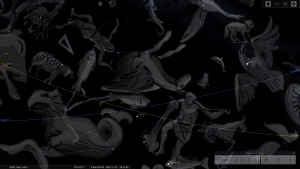
Screenshot from Stellarium.org of the Fishes or Whales, showing the graphics of the zodiacal animations with signatures (line of the composite). Enlarge for viewing details.
To naked-eye viewing, this zodiacal engram is huge but faint. The signature suggests a wide, sprawling V. Upon observation, it gives the impression of something floating, like a pair of flower petals on the placid surface of a dark lake. Those who taught celestial divination in the past brought attention first to the signature, the connecting lines. They instructed their students to see the two extensions of the Fishes as pointers. They stand at a right angle, not pointing oppositely. One line of the V draws the eyes upward from the ecliptic (Eastern Whale, leaping), the other draws the eyes along the ecliptic (Western Whale, diving or sounding). The extent of this composite — second largest in the sky after the Virgin — gives the impression of a vast reach across space, and perhaps across time as well. The master skywatchers taught that the Eastern Whale points to the distant past, and the Western Whale points to the far future.
Look closely at the vertical signature line. Where does it direct your eyes to scan? Notice how it points upwards to the constellation of Andromeda and to a particular detail there. The soft spiral you see below the right hand of Andromeda is M 31, the Andromeda Galaxy, the most distant object visible to the naked eye.
Ancient initiates who taught skywatching would have signaled that fact to their students and then added the graphics. Then they would have taught the story-line encoded in the celestial images: The Eastern Whale leaps up toward M 31. It brings attention to the myth of Andromeda, the Chained Woman. She is a captive at risk of an attack from the sea monster, Cetus, pictured below the Whales. This group of figures composes a vast celestial tableau. The mirroring of this tableau is running in your neuro-liguistic-image circuits as you read these words.
The connecting lines on Stellarium identify the signature of each engram by the pattern of most obvious stars. You recognize a zodiacal engram by its star-to-star signature. You can see clearly that the signatures that catch your attention upon naked-eye observation do not automatically suggest the corresponding animations.
For instance, the star-to-star pattern of the Manitu to the right (west) of the Fishes is odd and hard to visualize. You would not picture it as a man holding an urn that feeds currents to the Western Whale unless you were taught how to do so. Celestics teaches you how to identify the celestial animations and, at the same time, how to recognize the engrams that encode the plot factors of your biographical narrative. If your manifold displays any entries in the Andromeda-Whales-Manitu tableau — say, Jupiter under the tail of the Eastern Whale, or the Moon in the urn of the Manitu — you know immediately that your life-narrative is encoded with those mythic themes. You are cued and clued to the plot-line of your life. Each manifold entry is a faculty or innate talent for you to develop and express. You test and prove your mastery of that gift within the context of the celestial animation where it stands. That is the method of forensic astronomy in a nutshell.
The “Aquarian Age”
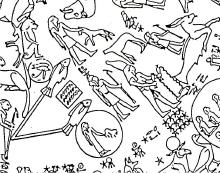
Detail of the Fishes or Whales, the Square of Pegasus, the Manitu and the Goatfish from the Dendera Zodiac. Note the distance from the Fishes to the Manitu and compare it to the Stellarium screenshot.
Look again at the horizontal pointer in Stellarium. It draws the eye from left to right, east to west, where it points to the Manitu, Enki. This is the constellation of the Waterbearer, not to be confused with the starless sign Aquarius. In the DZ Enki holds two urns overflowing with water. This tableau illustrates another story-line: The Western Whale swims into the currents streaming from the urn. The Manitu is the celestial image of the Waterbearer, not the sign Aquarius, as noted; but like Aquarius, it is associated with a time to come, a period in the future, the Aquarian Age. The general bearing of the two Whales is: Eastern leaping Whale :: antiquity, pre-history, the legacy of the past, sacred knowledge of our ancestors, contrasted to Western Whale :: the future, Modernity, the knowledge to be acquired in our historical timeframe, the visionary path to a future worth living. The next interval in cosmic time is the Age of Enki.
The Zodiac is the face of a star-clock. Each star in the celestial tableau has a particular date. The head of the Western Whale, another pointing formation, is a long way from the composite of the Manitu. There is a considerable gap between it and the urn. The DZ graphics clearly emphasize this gap. The nose star of the Whale is the star beta Piscium @ 349°. The blowhole is theta Piscium @ 356°. Due to precession (another topic!) each star has a date indicated by when the vernal point (VP, locale of the sun at the spring equinox) reaches it. The nose star dates to 2840 CE, which can be said to be the moment when the Age definitively shifts toward the the epoch of Enki. The blowhole dates to 2316 CE, also quite far ahead in time.
So, brace yourself. There is a long haul moving ahead into the “Aquarian Age.” Nevertheless, the currents streaming from the urn of the Manitu reach the Western Whale already and it swims into them. Some people today are acutely attuned to these “frequency waves” incoming from the future. They represent visionary forerunners of the next cosmic Age who introduce its futuristic themes into the world drama, even though humanity at large is still deeply enmeshed in the problems of the Piscean Age — namely, terminal narcissism and the absence of a meta-narrative to guide the species.
Naming the Constellations
Below you see the “story-book” names of the constellations which distinguish them from the astrological signs. Unfortunately, astronomers who discount and ignore astrology use the names of the astrological signs for the real-sky constellations. The constellations are observable star-patterns, the signs are starless zones, divisions of the orbital plane of Earth (ecliptic). The twelve signs comprise the ecliptic zodiac of 12 uniform divisions, the thirteen principal constellations comprise the real-sky zodiac of irregular formations. To learn the inventory, another set of names has to be introduced. Signs and constellations do not correspond or correlate but they do interface as the model shows.
RAM, not Aries
BULL, not Taurus
TWINS, not Gemini
*Celestial Anchor, interfacing Cancer, extending to Sirius and the Pleiades
CRAB, not Cancer
LION, not Leo
VIRGIN, not Virgo
* The Cache, or Treasure Chest, interfacing Scorpio
SCALES, or BALANCE, not Libra
SCORPION, not Scorpio
SNAKETAMER, the 13th constellation, interfacing Scorpio,
ARCHER, not Sagittarius
*Great Void, stretching between Archer and Goatfish
GOATFISH, not Capricorn
MANITU, not Aquarius
FISHES OR WHALES, not Pisces
Total: 12 principal constellations on the ecliptic rim + the Snaketamer = 13, + the Great Void = 14, + two accessory constellations, the Celestial Anchor and the Cache or Treasure Chest = 16 engrams.
Celestial Notation
The panorama of the real-sky constellations is rich in visual imagery and detail. For convenience, the complete range of graphic details can be plotted on a register of 360 degrees, like a circular ruler or protractor. Below you see a drawing of two women by Gustav Klimt with stars placed on their bodies and features, and a protractor positioned to identify details of the drawing by degrees. For instance, 10° on the register locates the small star on the mouth of the lower woman. 48° marks the elbow of the lower woman. 1° marks the nose of the upper woman. This illustrates how to identify details in the constellations by degrees. It is a technique you learn so that you can refer to the mythic images by locational shorthand.
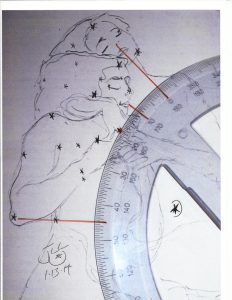
Original sketch based on a drawing by Klimt, Celestics Course, January 2014. The measures on the protractor locate details in the drawing. 45º on the full scale of 360º marks the right elbow of the forward figure. 45º is 15 degrees of the sign Taurus.
Each degree° on the protractor of ecliptic longitude can also be read in the signframe. Bear in mind, however that the sign degree is merely locational, it has no psychological value. This technique of location is easy to learn. It affords convenience in reading the positions of the entries in your manifold. For instance, the notation 340° or 10 Pisces takes you immediately to the face of the Manitu. The location 285° or 15 Capricorn draws your attention to the vane of the arrow in the drawing hand of the Archer, marked by the star Nunki. The notation 86° or 26 Gemini goes to the star marking the lower horntip of the Bull, called Al Haecka. The Crab Nebula, a spectacular deep-sky object, is also close to this celestial longitude. All these mythic cues and themes are encoded into your manifold.
The Full Ecliptic Register
The model below shows how to locate the constellations in these two ways: either on the 360-degree register of the ecliptic, or by reference to the signframe of 12 uniform sectors of 30 degrees. Notice how 30° or 30 Aries locates the knot in the cord of the Fishes, or Whales, called Al Rischa, directly below the tail of the Eastern, leaping Whale. If you find in your manifold that Venus has the ecliptic longitude of 30°, you know immediately where in the panorama of mythic images that entry in your manifold stands. If you have the lunar perigee at 230° or 20 Scorpio (Nietzsche), it stands at the fulcrum of the Scales or Balance. The Sun @ 205 ↔ 25 Libra (also Nietzsche) stands close to the bright star Spora that marks the sheaf of wheat in the left hand of the Virgin.
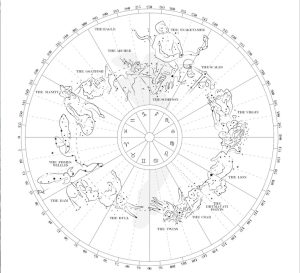
I propose the notation @ ECL° ↔ Sign degree as a handy way to write down these notations and learn to scan the field of visual references so that it becomes second nature, and you don’t have to think to make the conversion from number to picture.The trick is, do not associate the psychological meaning of any sign with its locational setting. A planet at the head of the Twins will read @ ECL 116 ↔ 26 Cancer but the psychological interpretation of Cancer is irrelevant.
Another example: my manifold contains the notation Mercury @ 260° ↔ 20 Sagittarius placing that planet in the Snaketamer on the thigh of the right leg, called the “20/20 line” (20 Sagittarius-Gemini) to indicate a specific property of that constellation. This location is close to the star Sabik @ 259°. With the faculty of Mercury (communication) I express the themes and plot-lines encoded in this locale. One theme of the 20/20 line crossing the right leg of the celestial shaman at Sabik is mastery of planetary Kundalini, the telluric force of mother earth. I have been the messenger (Mercury) for this theme in the system of Planetary Tantra and other instructional tools derived from my shamanic experiences.
The register above shows the constellations as if seen through a clear glass disk inscribed with the 12 starless astrological signs. They are all identified by their story-book names, distinguished from the Greco-Latin tag-names for the signs. Capricorn the sign is not the Goatfish, Taurus is not the Bull, Libra is not the Scales, or Balance. The constellations are not uniform in shape or extent. Make the count and you see there are thirteen of them. Don’t ignore the Snaketamer — as if you could!
Finally, note this detail. The rimsite model of the constellations is the template for all manifolds calculated for the moment of birth. It is equivalent to the deep-field celestial matrix of human experience on the mother planet. The section of the DZ below shows how the Egyptians identified this point. One of the five axes of the infrastructure of the DZ points to it.
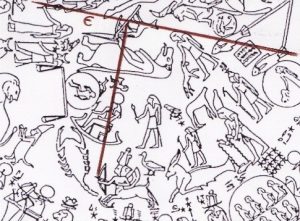
The constellation of the Archer, pictured here as a two headed centaur, aims at the galactic center @ 267 ↔ 27 Sagittarius. In naked-eye observation, you can trace the line of stars that correspond to the line of aim from the drawing hand to the forward hand, close to the tip of the arrow. The Egyptian priest-astronomers who designed the DZ intentionally taught this visualization to neophytes from Greece. If you observe the composite stars of the Archer without guidance in visualization, it is difficult to make out what celestial figure it might depict. Modern astronomers have only identified the line of sight toward the galactic center (GC) since the 1950s using radio telescopes and other instruments. But the DZ proves that ancient astronomers knew where it was centuries ago, if not millennia.
So, now you know why the Rimsite features the Archer-Snaketamer top and center. It immediately focuses your attention on the galactic core. Note also that the direction of line of sight to the GC stands above the stinger of the Scorpion.
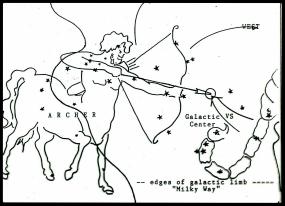
‘Nuff said. This menu item in Celestics is the longest of all. It offers a crash course on the Zodiac in both astronomical and mythical terms. It places you at the portal to a novel method of interpreting your life-pattern by investigation of mythic images in the night sky. This is an adventure in self-discovery unlike any other. The art and method of forensic astronomy can enhance your understanding of your personal life-pattern in psychological terms, but this is a by-product of the tool. Fundamentally, it is a method of decoding the composition of your life-narrative. The conventional starless format of the horoscope shows essential features of your life-pattern, your traits, tendencies, and complexes, and you work with it as best you can. By contrast, Celestics reveals the themes and plot-lines encoded in your life-narrative, and shows how you can compose it in a self-aware manner for the best outcome. This distinction relies on a simple truth of common sense:
The story you tell yourself about your life runs in parallel with the actions you undertake in life. The story is encoded with themes and motives that shape and drive your behavior, both day by day and over the long term.
I continually highlight that distinction throughout the introductory material on Celestics. I cannot emphasize it enough!
Astrology is a tool of psychological analysis.
Celestics is a method of biographical description.
Always remember that!
© John Lamb Lash 2025. All rights reserved
